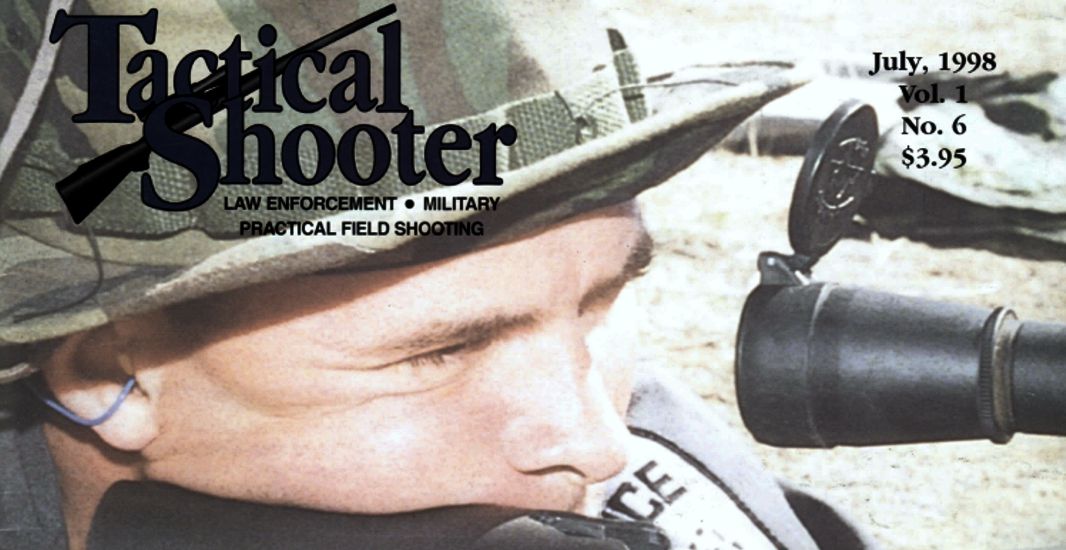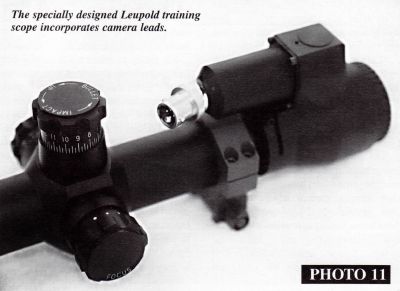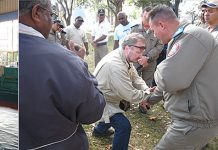The Man And His Mission
My first encounter with Billy Martin, President of LOD Training Associates and inventor and designer of the LOD Precision Marksman Sniper Rifle, came from an ear-numbing 4.5 hours on the phone.
A couple of weeks later, Martin and I had the opportunity to meet, this time for a solid 15.5 hours. It was, by that time, becoming clear that Martin is a man with a mission. In those first two sessions, I began to appreciate him as one whose intense personality is essential to the welfare of all of us.
It is intimidating to many of us to be in the presence of those who are driven … obsessed with what they are doing … unbending in their beliefs … dedication absolute. To many of us this is all very tiring: energy with no end in sight, constant focus. Images of a cold beer, a hot shower, and a good bed begin to overcome you. But that’s Martin.
Essential to the welfare of all of us? Martin, his company, and his staff are dedicated to saving lives. Surely the drive, the energy, the focus are virtues we ought to be thankful for … for it is that energy, drive, and focus that may someday save the life of you or yours, or train you to save others. By the time I finished working with Martin, his staff, and his students many months later in preparation for these articles, I had a high respect and appreciation for their efforts. For I learned that energy, drive, and focus are not nearly enough to deliver accurate first shot rifle fire on demand, under stress, and under extremely adverse and constantly changing conditions.
As an avid benchrest competitor for the past twenty years, I had lulled myself into perceiving the act of shooting as a rather easy, though puristic, accuracy pursuit that is hobbyist in nature. To that end there is certainly a considerable amount of technical specialization. The requirements for the position shooter extend that pursuit another step … an additional hardship, and an additional complication. The benchrest shooter’s activity centers around the creation of precise components, both ammunition and rifle. Once this is completed, the shooter’s final work is taken up with trying to beat the conditions between himself or herself and the target to put each round back into the previous hole. The game (and it is a game), for the most part, ends there. The position shooter (competitor) is faced with an additional problem: learning to hold the rifle in a skilled enough manner to put the bullet where he wants it to go. This holding the rifle is accomplished by the concrete bench for the benchrest shooter, and for many of us who shoot free recoil, we touch nothing but the trigger when the rifle is fired. For both, the distances and positions are established and known, and the target is paper.
The requirements of the tactical shooter are far more rigorous than that of either the position or benchrest shooter. In point of fact those requirements seem almost impossible or superhuman.
As much as I might like to, it is not my job to sing the praises of Mr. Martin’s personal traits beyond his ability to deliver accurate rifle fire, and whatever techniques he might use to enhance such an endeavor by others. In this light, Martin explains that there are several components/levels involved in the pursuit of first shot accurate rifle fire … delivered on demand, under stress. Put into broad categories they, in part, comprise the following:
1. Quality ammunition
2. A precisely and correctly built, ergonomic, accurate rifle and associated equipment
3. The relationship or symbiosis between ammunition, rifle, and shooter
4. Physical, mental, and technical preparation of the shooter
5. Knowledge of the technical aspects of engagement
6. The ability to handle stress and hard-ship in order to deliver accurate rifle fire on demand, under stress While the benchrest and position shooter might believe that all of the above are aspects of their own ability to deliver accurate rifle fire, they are not in the same league (no put-down intended). Accurate rifle fire to me, for example, means watching the flags and either knowing how to hold for them or waiting for them to return to the previous condition … the tactical shooter has no such flags. I take a considerable time to set my equipment on the concrete bench and adjust my equipment … the tactical shoot-er has no bench, and the luxury of time may or may not be available. In point of fact, the tactical shooter may have to drag his rifle (like a snake on his belly) over several hundred yards in order to deliver fire. My target rests firmly stapled to the backer without emotion or concern, not daring to move, while I take any number of sighters to ensure a good hit on the record target. The tactical shooter does not have such an accommodating and predictable stationary target, and sighter shots are not allowed. For law enforcement, one shot incapacitation is required, and the consequences are dire.
The consequences of good or bad shot placement on the target of a benchrest shooter are inane indeed (though to watch some competitors, you might not think so). The benchrest and position shooter has a known, predetermined distance that can be set in his scope with leisure and assurance and without dire consequence.
But the fact is, the tactical shooter must shoot at any distance, without benefit of contrived aids, sighter shots, the latitude of predetermined time requirements, under stress, and in hardship conditions. And again, he must do so, in most cases, with one disabling shot.
If this feat can truly be done, it is with considerable interest that I hoped to find out how! I decided it would take some time and several sessions, dedicating my own time to convince myself of the possibility, and of the probability of success when humans are asked (ordered) to accomplish such awesome and life saving deeds under such considerable stress. I was beginning to understand Mr. Martin’s fervor for his life’s work.
By now you realize that I am not a sniper, nor have I ever been trained as one. The editor of this magazine assigned me the task of determining the accuracy that can be delivered by these rifles and by these men under field conditions. The only assurance that I can give you that this article holds anything worthwhile for you is that I tried my best to give an accurate and exhaustive account of what I found by studying LOD’s equipment and training procedures for several months.
Most probably because of my background there seemed to be a logical course: first, establish for myself the ability of the rifle(s) and equipment to deliver precision accuracy. This is the purist side of the endeavor, and the one with which I am most familiar. This is the primary goal of the first three requirements of Martin’s list above. With that accomplished (if, indeed, it could be), the second requirement would be to participate in the training offered by LOD and see the results for myself. This activity would concern itself with the last three of Mr. Martin’s list above.
This effort was rather exhaustive, and, because of space requirements in the magazine, had to be accomplished in 3 parts. Part 1 explores Martin’s self designed LOD Precision Marksman Rifle. Part 2 presents the tests I used to establish the rifle’s accuracy, using Statistical Process Control Analysis to validate their predictability. Part 3 finds me trying my best to keep up with that younger generation whose eyes and reflexes are only things that flutter, now and then, in and out of my memory. This was at one of Martin’s training courses conducted at the White Sands Missile Range in New Mexico in early March, 1998.
To accomplish the first step, Martin graciously gave of his time to travel to Corpus Christi for a full day to familiarize me with his rifles, stocks, ammunition, and information. We shot several rounds throughout the day, Martin explaining what he could to an old dog like myself. He delivered that equipment several days later for my use, trusting that I could determine for myself just what the accuracy level of his equipment is.
The Man And His Rifle
We drove to my range, arriving shortly after dawn. Each of us unloaded our equipment, wondering the whole time what the other had in mind for the day. For one, I had no intention of laying down in the prone position with the idea that I could emulate a tactical shooter. Thus I began arranging my front and rear rests on the bench, placing my flags, hanging targets and mirage board, looking silly, I’m sure, to the accomplished sniper. I tried to keep in mind what my job was … evaluate accuracy … remain the purist.
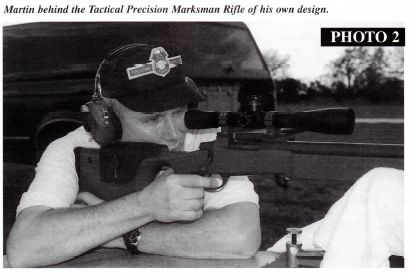
Martin was polite and accommodating, helping me to do whatever inane, little hobbyist activity I wished. With finality he handed me rifle and ammo, apparently giving his approval to do with same whatever I might. The caliber was .308, but I was informed that he supplies .300 Win Mag and .338 Lapua as well. If you don’t like those, Martin will supply the stock only, fitted to accept your barreled action.
First impressions: The LOD Precision Marksman Rifle (Photo 3) he handed me was OD green, a far cry from the elaborate colors of a bench gun … as well it should be! But once I got beyond that, I was intrigued by the utility of the design, and, in fact, got to like the color. The stock is most imposing. I thought it a bit unusual at first glance until each of the features were explained and I considered them. With some modifications that are peculiar to the tactical shooter, the cheek piece is adjustable (Photo 4). Martin has relieved a portion of the rubber-covered metal attachment at the top, front end. This accommodates the removal of the bolt when the cheek piece is positioned above the stock for a proper spot weld fit of the shooter (Photo 5). I found this cheek piece particularly comfortable … a welcome feature for the man who has to lay over it for hours. The rubber is comfortable and accommodates cold, wet, or harsh conditions very well. Returning to the stern, the recoil pad incorporates spacers to, once again, accommodate fitting the individual (photo 6). These spacers are unique in that they can be easily raised and then swiveled out from the stock. Both adjustments can be made quickly.
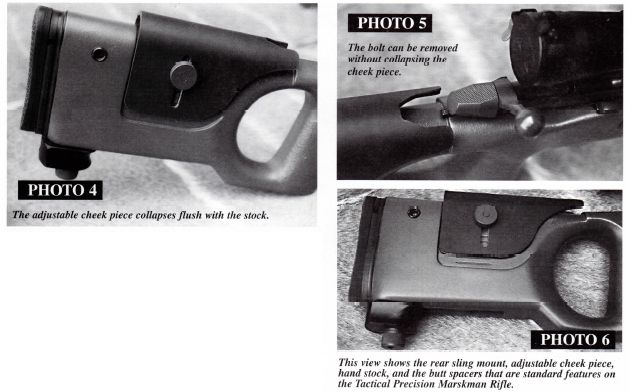
The pistol grip is of the modified thumb-hole variety, with the angle of the grip advanced forward to match the natural angle of the resting arm-wrist-hand structure. Afteradjustment, I found that these features tended to put me very quickly into a comfortable, correct posi-tion to take advantage of the full image in the Leupold Mark 4 M1 Tactical Scope’s eyepiece. This design also accommodates left hand shooters or shooting weak handed.
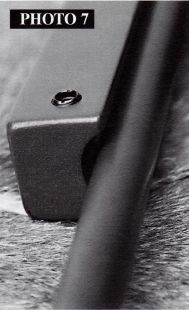 Advancing toward the bowsprit of this critter, I found a flat forearm and generous free floating of the 25 inch, match grade Krieger barrel (Photo 7) whose 1:11.25 twist and heavy configuration had been stressed relieved and lapped to perfection. Note the sling mount in this photo. The McMillan stock, designed by Martin, supported the 151/5 pound rifle on my rests without deformation or vibration. Embedded rails complemented the underside of both the forearm and butt (Photo 8). These slide rails can accommodate the sling in any desired position, the rear being attached to a target hand stock that allows the shooter to place the web of his left hand in a groove for sup-port (Photo 6). This thumb-forefinger web rest is supplied by Kengs Firearms based in Atlanta and is used to reduce muscle tension and promote a relaxed, steady position. When installed in the front rail, the forearm supports a versa pod, also supplied by Kengs, for sup-ported prone fire.
Advancing toward the bowsprit of this critter, I found a flat forearm and generous free floating of the 25 inch, match grade Krieger barrel (Photo 7) whose 1:11.25 twist and heavy configuration had been stressed relieved and lapped to perfection. Note the sling mount in this photo. The McMillan stock, designed by Martin, supported the 151/5 pound rifle on my rests without deformation or vibration. Embedded rails complemented the underside of both the forearm and butt (Photo 8). These slide rails can accommodate the sling in any desired position, the rear being attached to a target hand stock that allows the shooter to place the web of his left hand in a groove for sup-port (Photo 6). This thumb-forefinger web rest is supplied by Kengs Firearms based in Atlanta and is used to reduce muscle tension and promote a relaxed, steady position. When installed in the front rail, the forearm supports a versa pod, also supplied by Kengs, for sup-ported prone fire.
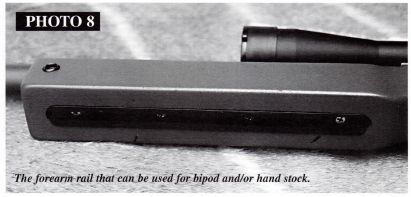
Martin displayed an identical stock that had not yet been mated to a barreled receiver. The receiver channel is standard with the exception of stainless pillars, uniquely machined to provide positive support for the receiver. Martin seats the barreled action to the stock using a torque wrench that delivers 65 inch pounds. The stock can also be supplied in Brown, Gray, Black, or Desert Tan for both short or long actions popular on today’s market to include: Sako, Remington, Ruger, Savage, and Winchester. Martin has designed the stock to reduce recoil effects as well.
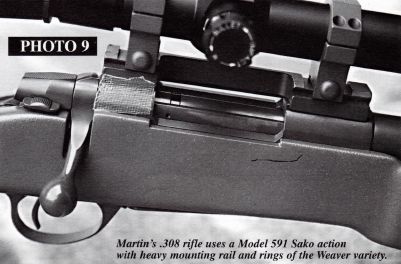
The Sako action, preferred by Martin for its function and economy, as well as the barrel and stock, are epoxy coated for corrosion resistance and lubrication. The color is applied to all parts of the rifle with the exception of the previously mentioned cheek piece, slide rails, hand stock, recoil pad, spacers, and barrel interior. The Sako action is the two lug variety with modified Mauser-Sako type extractor (Photo 9). Martin applies specialized moly lubricants to the receiver rails, and even goes so far as to include specialized coatings to the internals of the trigger. This is either epoxy, epoxy-Teflon mix, or Teflon depending of the friction and function of the part. The scope base mount, of Martin’s design, is a stout, one piece rail system positioned on the Sako dove tail and mounted with double screwed rings of the Weaver type (Photo 10).
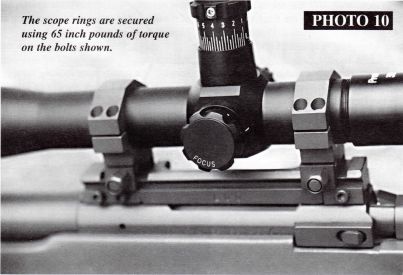
The base on the .308 has a 15 mil pitch while the base on the .300 Win Mag has a 20 mil pitch. Martin uses the same supplied torque wrench to seat the ring screws to the base as well. This con-figuration allows the use of night vision optics and other devices such as a camera (Photo 11) mounted inside a specially designed scope. The Model 591 Sako action is used for the .308, while the Model 691 is used for the .300 Win Mag. The bolt on these actions is lapped, the actions squared, and then disassembled and epoxied inside and out. A special Moly coating is applied to the raceways and lugs during the second epoxy treatment. The bolt is then lapped into the receiver rails until a glass smooth action is obtained.
Martin prefers the Leupold Mark 4, M1 Tactical Scope, and he had provided one in black matte with the rifle that I placed on my rests. I stood while adjust-ing the focus (Photo 12) of the eyepiece and parallax for the 100 distance at which I intended to start shooting. I bore sighted the scope and sat down to begin firing. I stopped myself, realizing that I had no familiarity with the trigger. I let it off a few times, finding it to be light (2.5 pounds) and crisp for a factory trigger. I measured the trigger pull several times, finding it hard to believe that it was as heavy as 2.5 pounds.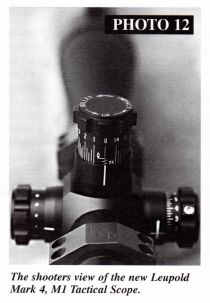
Martin handed me several boxes of unfamiliar ammunition and invited me to take my pick. Mmmm, I mused, how would I make a selection? I liked the blue and white box … blue being my favorite color. The name Lapua jumped out at me. “How about that one … the pretty blue box,” I said, pointing. He handed it to me. I looked back down range and began to be a bit more relaxed. It was a familiar sight: flags wavered languidly, switching from 10 to 2 o’clock, targets on the backboard, the black and white striped mirage board. I looked through the scope. There were dots everywhere … mil dots. That’s nice, I thought, and tried to focus my attention back to the intersection of the crosshairs. OK, I can handle this.
I studied the flags for a few moments, realizing that Martin and his friend, Brian were looking at me and at the target through the scope waiting for the result. Little did they know … They are used to engaging the target, assessing the condi-tion, and sending the shot. Me, I’m wait-ing to find the predominant wind. That would take several minutes. When it came, I fired at center mass, hoping to find the bullet and make the adjustment to bring point of impact back to point of aim. Bang … left two inches, vertical fine. I held the crosshairs on the original point of aim, and with the rifle secure in the rests, brought the crosshairs to the bullet hole. Somewhere in the rear, I could faintly hear Martin’s authoritative voice coming through my ear muffs, muttering something about the time. Guess he was wondering if I intended to shoot today or tomorrow …
“Two minutes right, quarter minute come-down.”
Dots, minutes, mils … a strange way to describe hold and clicks. Oh well, let him ramble on, I’ve got a group to shoot and flags to watch. I swung the rifle slightly in the rests until the crosshairs centered a nearby bull. First shot, center bull. That felt good, no unpleasant recoil, no terrible report. The rifle moved straight to the rear, riding the bags like it was made for them. I didn’t want to load from the magazine, and found myself fumbling a bit trying to unload and load single rounds by hand. Second shot, center bull cutting the first. Third shot, in the same hole. I was now staring through the scope at a three-shot .122 inch group that was cutting the center of the bull out. I considered quitting right there. I bit my bottom lip and got back in position … I was getting the typical benchrest jitters. I watched the flags intently, lost in my own technique, unaware of either Martin, his friend, or much of anything else. The forth and fifth shots went into a single hole measuring .077 just above the previous three, expanding the final group to .457. I was impressed. That blue box might be gold. Little did I know …
Martin handed me another box, this one with Hornady’s name adorning the top (this was not Hornady’s latest offering for the Tactical Shooter, I later found out). This group didn’t fare so well, measuring .985. My curiosity was peaked. I asked him if I could have the pretty blue box again. I extracted another five rounds and let fly. The group once again cut center bull with the first four measuring a nice .297, the final bullet dropping out the bottom for a .587. Martin handed me a second variety of Lapua ammo of some other weight and configuration. This group didn’t fare quite as well either, measuring .745. By now the winds had picked up and were switching left to right to a straight tail wind that crossed the line of the flag poles with a vicious flip.
My curiosity was really growing by this time. I asked Martin for the pretty blue box again. This time I tried desperately to hold my concentration through the group. I had changed the settings on the scope slightly for the previous load and didn’t bother to bring them back as I got into position to shoot the pretty blue box stuff once again. As I shot, the hole did not appear to get any larger through the 10 x Mark 4 Leupold. After the third shot, I could tell that it had a bit of horizontal in it. I finished the group, and we walked forward to assess the final product at close range. The final “pretty blue box” (Lapua 167 grain Scenar) group was a tidy little .267, making the three, five shot groups agg .437, the best of which was shot in some nasty winds.
“Let’s move to 400,” I boldly suggested. We did, and placed a steel target below the target frame as well. This handy devise allows the steel target facing the shooter to bounce back to its original position when a hit is made. Why didn’t I think of that?
The winds had, by now, gotten difficult to handle. I started on the paper targets. My first round was low; the second shot, after a vertical adjustment, was high. I made a third adjustment and shot three times, aiming approximately 6 inches left to oblige a predominant left to right blow. I had no idea where the bullets were printing since the 10x could not resolve the hole through the mirage … by now severe. I completed the remainder of the three shot string and looked back at Martin.
“I don’t know,” he said, looking through the Leupold variable spotting scope. “It’s mostly haze looking through the mirage, but I think they’re in a little cluster at about 4 o’clock, a half minute from center bull.”
There he goes again, I thought, combining time with bullet placement. Being the lazy humans that we are, we climbed aboard the pickup and rode the distance to the 400 yard backers. He was right, the last three, after adjusting the scope to tar-get, was in a little cluster measuring about .460. I next tried the 4 inch metal target from the 400 yard line, hitting it three times in succession, Martin acting as spotter and giving me hold-off commands. The hits proved to be near center with the group appearing to be approximately 1.5 inches.
I was impressed with Martin’s rifle. Comfortable and authoritative, it took the targets like it meant it.
We ended that first day talking philosophy, equipment, technical riflery, and Martin’s background. He looked at me thoughtfully at one point and explained that he couldn’t remember a time that he didn’t have a rifle in his hand. At 51, he has been involved with and/or taught courses in the field of firearms for thirty years. He created and runs LOD (Line Of Departure) Training Associates as a natural outgrowth of his many years in the field of firearms training.
Shooting with and talking to Martin was an enjoyable and interesting experience. But my assignment was to extract the capability of his rifle and his program … his ability to instruct and deliver first shot rifle accuracy on demand, under stress. To do this, I intended to: 1. work with his rifles from a statistical point of view, and 2. attend his training course to see the results of marrying such a tactical rifle system to a sniper team. The results of these evaluations will be the subject of Part 2 of this series and Part 3 of this series.
LOD Precision Marksman Sniper Rifle Part 2
Accuracy Capabilities of a Modern Sniper System Part 3
Article by Jacob Gottfredson in Tactical Shooter, July 1998

